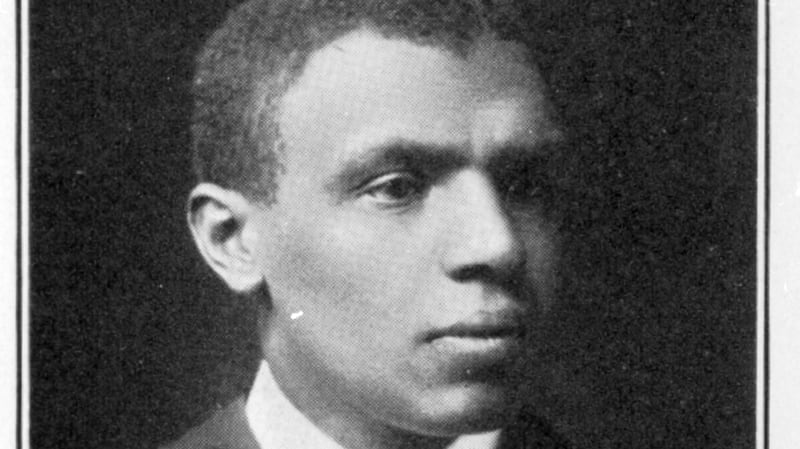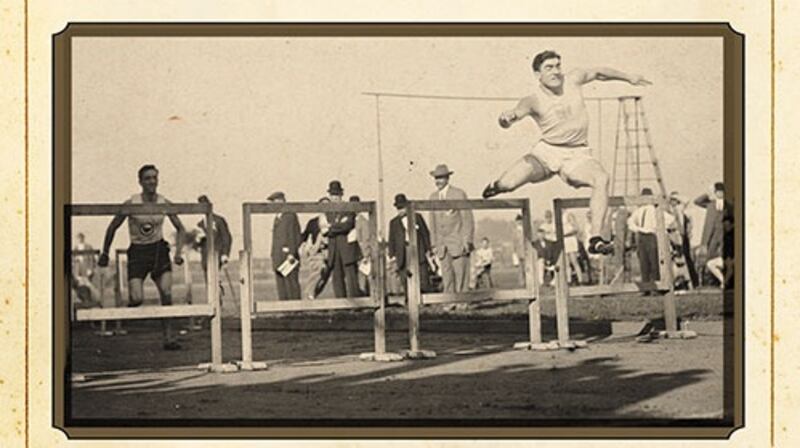One hundred and ten years ago this year, the first athlete of African descent won a gold medal at the modern Olympics. John Baxter Taylor, a former veterinary student from DC born to former slaves and a member of the American Medley Relay winning team, broke this milestone at White City Stadium on July 25th, 1908. Equally remarkable was Taylor’s choice of athletic club back home: The Irish-American Athletic Club of New York.
1908, the same year Jack Johnson’s punishing victory over Tommy Burns in Sydney would create the deepest racial schism in American sport, was hardly an easy time for an African-American athlete. While athletics’ integration would be unseen elsewhere for over 20 years, racism remained prevalent.

As a sideshow to the 1904 Olympics, its misogynist organiser, the athletic “czar” of America James Edward Sullivan, had organised “Anthropology Days”. What the New York Times had labelled a “gathering [OF]types and freaks from every land”, saw untrained non-white “athletes” brought over solely to prove white superiority in sport.
In the Spalding Athletic Yearbook Sullivan edited, he smugly concluded: “We have heard of the marvelous qualities of the Indian as a runner; of the stamina of the Kaffir, and the natural all round ability of the savage in athletic feats, but the events at St Louis disprove these tales.”
Mark Twain was so disgusted that he publicly refused to attend the event. But luckily for Taylor, Sullivan concentrated his efforts on excluding women from athletics - ironic as there remains an annual American award in his name for the best amateur female athlete - a feat so successful, only his death in 1914 ended the ban.
Celtic Park
Taylor was one of 11 Irish-American AC's Gold medallists in London. Initially called the Greater New York Irish Athletic Association, the I-AAC was just ten years old and hailed by New York's Evening World as "the first, if not the foremost, athletic club in the world". Founded by Patrick J. "Pay-Jay" Conway, a Limerick born blacksmith, it bought a patch of land in today's Sunnyside neighbourhood of Queens. On Memorial Day, May 1898, Celtic Park opened, becoming the home of most New York's Gaelic games until Innisfail Park (now Gaelic Park) opened in 1928.

Initially utilised by the city’s Irish societies, trades unions and small athletic clubs, Celtic Park was soon hosting the I-AAC’s own events, while the club gambled successfully on bringing back indoor athletics to Madison Square Garden with the Monster Carnival of Sports in December 1902. In St Louis, 1904, shortly before the Olympics, it took its very first national AAU Championship. It would win every national title it would enter - ten in all - until America’s entry into the first World War in 1917, except in 1915.
Members included some of the greatest names in Irish athletics: Martin Sheridan, John Flanagan, Matt McGrath, John Daly, while Peter O'Connor and Denis Horgan competed for the club when visiting. After London, foreign athletes on "sabbatical" like Hannes Kolehmainen, Emilio Lunghi and even the Englishman Harold A Wilson joined the club. Eyebrows were raised, with the Dundee Evening Telegraph sarcastically remarking that Kolehmainen only joined because the I-AAC were first to meet him disembarking: "Otherwise he might conceivably have become affiliated to the Greek-American Club, the Chinese-American Club or the Hebrew-American club."
However, Taylor’s membership personified a true inclusive American club, a policy born out of necessity if nothing else. Meyer Prinstein, the Russo-Polish born Jewish quadruple Olympic Gold medallist, was signed in 1902, becoming the GNYIAA’s first championship winning athlete when he took that year’s Metropolitan Long Jump title. Other Jewish athletes, like future Olympic medallists Abel Kiviat and Alvah Meyer, followed, while WASP’s like Mel Sheppard, one of the greatest middle-distance runners of the time, were also enlisted.
Prinstein was good enough to join the more established New York Athletic Club, the nation’s most successful team of the time. But this was a snooty and prejudiced establishment, one not altogether anti-Irish - Flanagan joined the club upon arrival and others like McGrath and James Mitchell were prominent members - but where Tammany Hall “sports” like “Boss” Richard Croker and “Big” Tim Sullivan remained “unclubbable”. Prinstein wasn’t getting in either, and Taylor would certainly remain excluded when a boycott against the club’s racism began in 1968.
‘Great applause’
It was in 1905, just as the club got its new name, that Taylor made his New York debut. Representing the University of Pennsylvania, the New York Tribune noted he was "hailed with great applause" at the I-AAC's Winter Games at The Garden. Moving to New York two years later, rumours abounded that Taylor had been black-balled by the Pastime AC, causing some leading members to resign in protest. 'Pay-Jay' saw an opportunity, although the I-AAC denied they were picking up any reject. The New York Times reported that '"n view of his ability and favourable reputation [THE I-AAC]considered it proper not to draw the colour line…"
Trouble was, in contrast to its athletes, there was little to suggest membership was anything other than ethnically Irish, and the meeting admitting Taylor laid bare the deep seated prejudices within New York's Irish at the time. A New York Mail report is disconcerting not just for mocking Irish brogues, but how free and easy members - Conway included - used the "N" word. Pay-Jay swayed the attended with a resounding speech: "Our name is the Irish-American Athletic Club, and under that wurrud, American, comes our justifcableness in having these Dootchmin and Jews as our fellow-members, an' where there's room for Dootchmin and Jews, there's no excuse in this wurruld for keeping out a man like this excellent naygur, more power to his lungs and speed to his legs."
To put this into some context, four years later the NYPD hired its first black cop. And yet no other major black athlete ever competed for the club. It wasn't prejudice: Taylor had crossed the club's racial Rubicon, and as The Sun observed in September 1907, "there is no athlete more popular with the Celtic Park crowd that Taylor… every man of the Irish contingent around the track roots himself hoarse to see Taylor win." More likely was that black athletes were joining the city's fledgling African-American athletic establishments, like the Smart Set and Salem Crescent clubs.
Tragically, Taylor never saw the end of 1908, dying of typhoid in December. It would be easy to dismiss his death as an aberration, but two of his teammates in London didn’t see out the following decade either; “weight men” Ralph Rose died of typhoid in 1913, and Taylor’s I-AAC teammate Martin Sheridan died of Spanish flu in 1918.
By 1920 the great I-AAC team had also died; the club’s offer to help out Uncle Sam’s war effort entailed losing all its athletes. Celtic Park survived, the perfect place, in a country that outlawed alcohol, solely to get drunk and shot simultaneously. Conway lived until January 1932 long enough to witness Celtic Park being sold for housing development. What was once “the first, if not the foremost, athletic club in the world” was now a memory.
Patrick R. Redmond lives near London and has written for BBC online, the Irish World and Irish Post, and is the author of The Irish and the Making of American Sport: 1835-1920, which is available to buy online from Mcfarlandbooks.com or Amazon.











